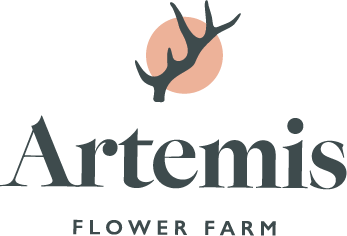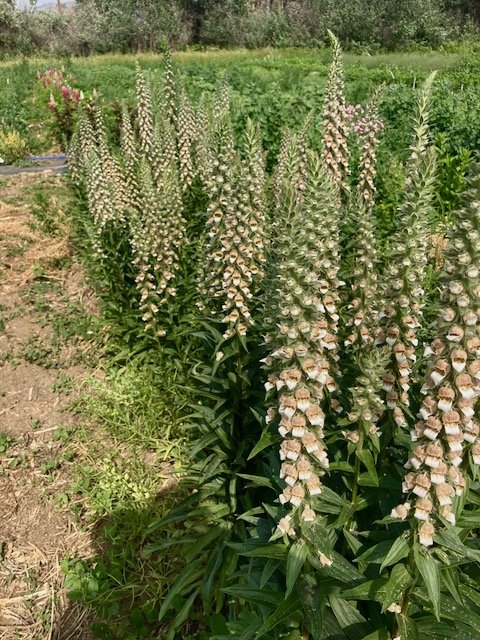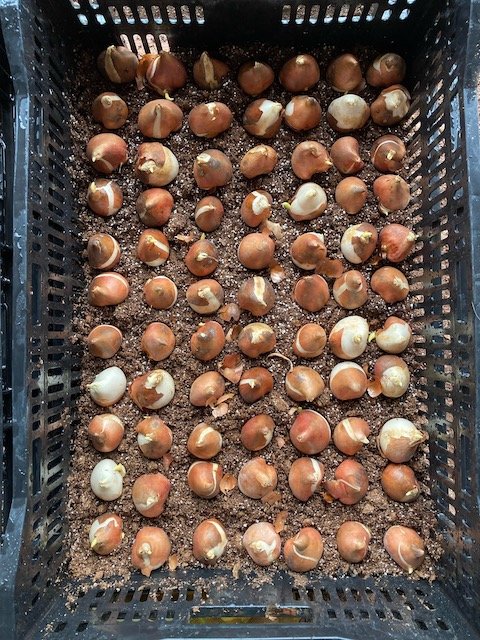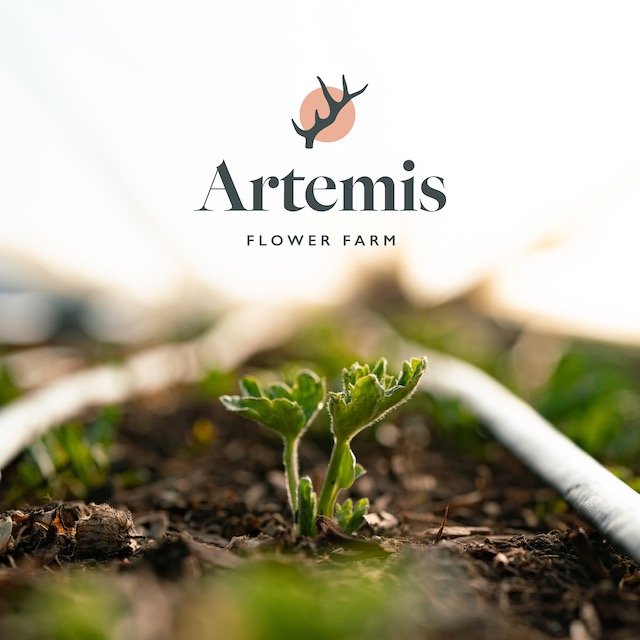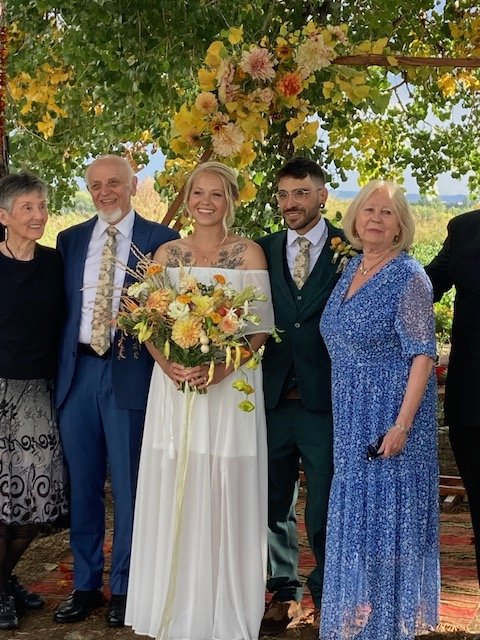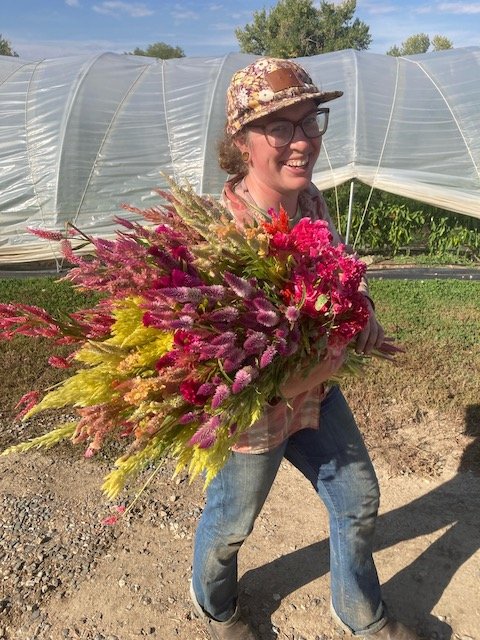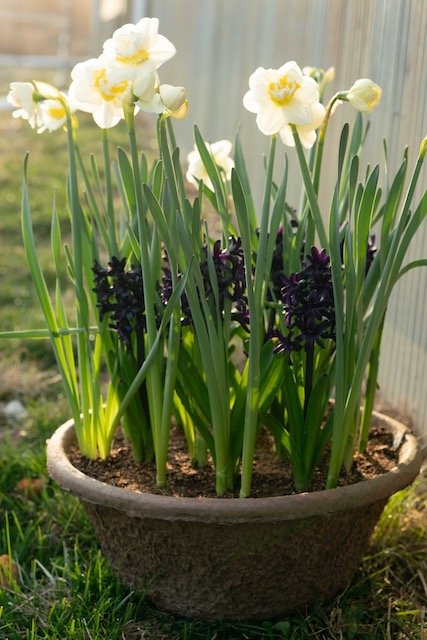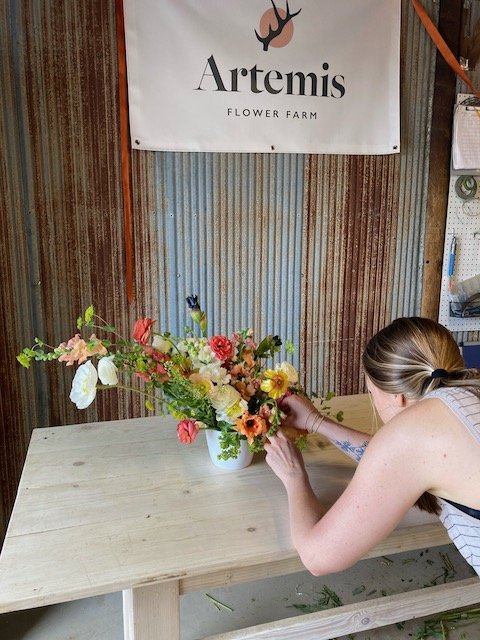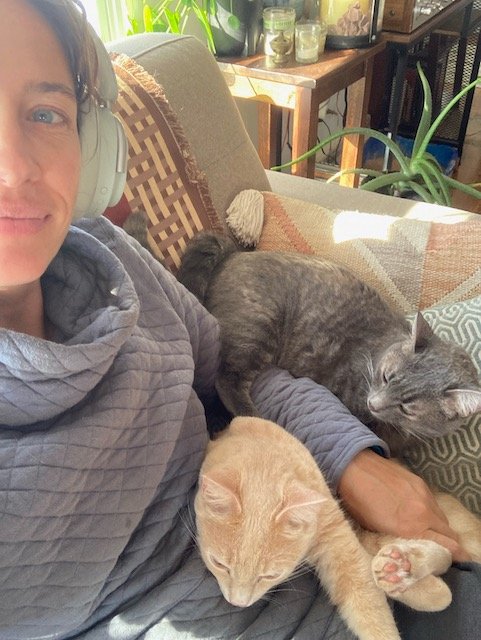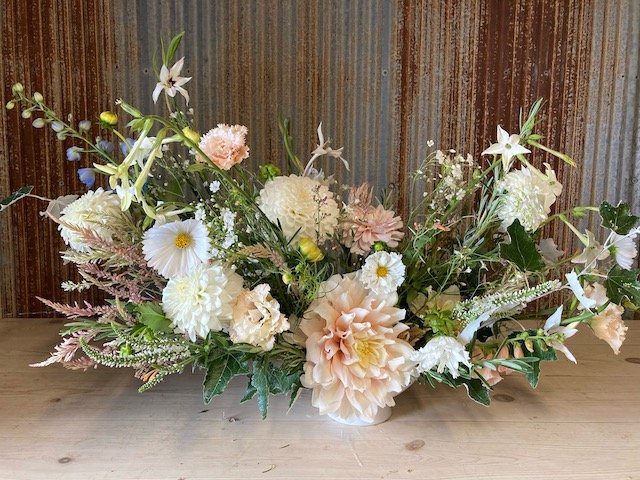2022: Year in Review
Safflower - doesn’t it just make you swoon?
What a year. It was tough, it was great. It was hard mainly because, as usual, I wasn’t living up to my own impossible expectations (surprise, surprise). It was hard in a much different way than last year, or any years past, because it felt like my plants weren’t happy, and like somehow I was falling behind my past achievements, even though this was my 9th season farming.
At the same time, 2022 was financially the most successful year in my business’s life, and it feels like “hey, this could actually work”. We accomplished so, so much, and we’re looking forward to much more. We’re starting to see that soon, Nelson will be able to work full time with me on the farm, which will only propel our business further forward, and that we might be able to have the life we want.
Y’all, this turned out to be a long post, so I’ve broken it up for you. Feel free to bounce around with the menu below.
1. The Weather
The Marshall Fire blazes on the horizon, as seen from the farm.
2022 started off with the black clouds and deep pain of the Marshall Fire, which burned over 1000 homes in Boulder, and was followed by the first snow of the year, extremely late on December 31. The very next day we launched our dahlia tuber sale, and gave 10% of the proceeds to the Community Foundation, which was helping to distribute food, shelter, and further aid to fire victims.
The dry fall and winter, followed by screaming spring winds, meant that our bulb crops had a lot of trouble. In the fall of 2021 I had planted thousands of daffodils, and when they came up, many shriveled, desiccated by the air humidity of 7% and less. We spent long hours watering our tulips so that the same thing wouldn’t happen, and we ended up with a great tulip crop. Most of it went to our spring flower subscription members, and to the Nederland Farmers Market on Mother’s Day. Our forced spring bulb pots were also a hit and really easy to make, except that the mice in our barn are PERSISTENT and VICIOUS and they ate a lot of the hyacinths. Trying to keep them out of my forced tulips at the moment (there is a ring of about 12 traps around the bottom of the crates).
Daffodils desiccated by the fierce winds and low humidity.
2. Greenhouse Pests
This year we decided to import some good plant-starting soils from a company in the Northeast, and though we’re not certain, it seems like along with the soils the company delivered a brood of fungus gnats (Bradysia impatiens). These horrible greenhouse pests lay their eggs in moist soil, and the translucent larvae feed on the roots of young seedlings, molting into adult gnats that can lay yet more hundreds of eggs. Many of our plant starts were decimated, especially in the later part of spring, which meant that many of our late season successions simply didn’t happen, and much of the farm was empty after July. It was tough to watch the plants die despite all our care, which included spraying and sprinkling Bacillus thuringiensis (Bt) on the roots, applying Neem oil, setting sticky traps, and applying beneficial nematodes. There are further strategies we plan to use this season if we see pest activity, including predatory mites and rove beetles, and we hope that we won’t have to resort to pyrethrins.
3. A Difficult No-Till Transition
Our growing difficulties extended to the field as we continued transitioning the farm to no-till practices. While I still believe that not tilling is right for our soils, this year not tilling was a huge issue and showed me lots of soil dynamics that I wasn’t aware of, and differences between my farm and the farms that practice no-till market farming successfully at scale. I’ll go into some of these differences below (feel free to skip if you’re just here for the gossip & updates :).
Moisture and decomposition rates
Many, if not most, no-till practitioners are farming in areas of the country that simply have much more precipitation and moisture than we do in Colorado. Our annual precipitation is somewhere between 15 and 20 inches per year, whereas most places east of the Mississippi, or on the West Coast, receive 2-3 times as much, or more. While we overcome our relative lack of water through giant water diversion projects, pumps, drip irrigation, and more, the simple lack of moisture in the environment, and the fact that the relative humidity almost never crosses 50%, means that our environment is simply dry. Without moisture, decomposition of organic matter proceeds much more slowly, and any organic matter added to the soil therefore breaks down more slowly, releasing its nutrients more slowly and changing soil texture more slowly. The no-till transition in these soils is SLOW.
Differences in soil texture
In Colorado, our soils are high in clays. Soil with a lot of clay is generally “tighter” or more compacted - that’s just the nature of clay. Because of this, there is less room in the soil for air space, and less O2 also means less or slower decomposition, because the microorganisms doing the work need air to breathe. Combined with low precipitation and humidity, low oxygen levels compound the problem of slow decomposition.
Access to affordable compost
Microorganisms also need food to eat. In much of the country, compost is much more affordable than it is here on the Front Range. I don’t really understand all the reasons why, but part of my guess is that our low precipitation rates mean more irrigation of compost facilities and therefore more labor, materials, and costs. I’m sure there are other reasons. I was listening to a podcast recently and the guest said they were getting compost delivered for $8 per yard. We pay $25/yard from almost any source, or, if we get it from a far away source like Vermont Compost, it can be much more due to shipping fees. So it costs us 3x as much to use compost on our farm as it does for places in other climates and states, and compost really forms the foundation of no-till systems.
So in 2021, our first season, I was still seeing the benefits of tillage and likely the residual fertility that the previous tenants had applied. Plants were growing great and the soil was easy to work with, even though we built our beds with just one pass of a power harrow, which does vertical rather than “turnover” tillage like a rototiller. I thought I’d hit a goldmine, because everything was growing like gangbusters and I hadn’t used hardly any compost or fertilizer.
This year was a much different story. The dry winter and spring, combined with no tillage, little compost (because it’s expensive), and no fertilizer (because I foolishly thought our soil didn’t need it) meant that I was left with really tight, dry soil. Clay shrinks as it dries out, which means there’s even less pore space for water and air to get into, so even just getting the soil wet can be an issue. We use drip irrigation on all our beds, and this summer I noticed that the water didn’t spread out as much between the emitters. It seemed like the water was just sliding down through any hole it could find, like worm tunnels or cracks, and slipping down to the B horizon of our soils, which is not far below our A horizon, and is an even denser clay. Since I hadn’t used tillage, the soil was not loose, and was not uniform, so where I would normally expect to see a wet spot about 6” in diameter around each emitter, I saw something more like 3”.
My plants were suffering from water stress though I was irrigating every day or every other day. Cracks formed on the surface. As a cut flower grower, I’ve always been taught that overhead irrigation is a no-no, because it wets the leaves and buds, leading to potential disease and making harvest a pain. In addition, overhead water often doesn’t even make it down to the soil because of how tall flowers tend to be. But I’m starting to see that overhead irrigation may be essential in our no-till system, at least until the leaf canopy closes and shades the soil.
There were some areas of the farm where the clay, drought, and nutrient deficiencies gave me the opposite problem: water was unable to move down into the soil, due to some kind of hard pan or tough horizon, and plants were suffering from anoxic conditions at the root. Basically, the water was stagnating and pooling under the soil surface, excluding oxygen and drowning plants’ roots. This was happening very unevenly across my fields and a lot in my hoop houses, so I’d have the front and end part of the bed really dry while the middle was sodden and growing algae at the surface. It was incredibly demoralizing and challenging, in a year when I was hoping to be “on top of it” (I no longer hold out hope for that ever happening 😂).
In August, (f*cking August, amirite?) when everything was looking its worst, at the end of the hot hot summer heat, I threw a tantrum. I had been working my tail off trying to deal with the soil issues — broadforking, adding gypsum, tarping to smother weeds, and I decided to just cover crop a lot of beds because nothing was working and I didn’t have any more transplants due to the fungus gnats killing everything — but I couldn’t even get the cover crop in the ground. I had this one bed that was just so tough: I couldn’t push a wheel hoe or a scuffle hoe through it, though it had been under a tarp for a month, the Tilther couldn’t break the surface, and I had just about had it. Oh the weeping and the gnashing of teeth! The cursing and the shaking of fists!
4. The Savior: Cover Crops
Inspiration Mel left for me after my tantrum.
Thank goodness I have farm partners. Cody and Melissa (Speedwell Farm & Gardens) calmed me down, gave me some sage advice, and helped me see that all was not lost just because I might have to till one bed to put in a cover crop. So we grabbed this old tiller that Nelson’s family had donated and tilled enough to get seeds in. Two days later, it rained enough that I was able to get enough tilth with the wheel hoe on the other beds I wanted to cover crop, and a little anxiety passed, and a little joy was born. I went to Pawnee Buttes Seed to mix up a blend of sorghum-sudangrass, oats, field peas, cowpeas, and a “turbo” tillage radish, all of which will winter-kill. We seeded 9-12 lines per bed with the pea plate on our Earthway seeder, and hand-watered until we got good germination & establishment. The drip was mostly sufficient after that.
My employee Kailey said that the cover crop was one of the best things about our season, and I have to agree. The sorghum-sudangrass and oats grew big, tall, and lush, and the peas soon overtopped them. The cowpeas hopefully fixed a bit of nitrogen before they got shaded out by the taller crops. The tillage radishes grew to about 4” in diameter and pushed up out of the ground. The whole thing just looked like we really knew what we were doing, haha. It made the farm look lush and beautiful. We’ve now had about 3 good snows and temps down to the single-digits, so the cover crop is pretty dead and smashed down, but those roots are still holding the soil and the biomass is acting as mulch, holding in that moisture, and the roots are still providing microbes with food when they are active. The hope is that by March, when I’ll need to start preparing beds, the cover crop will have mostly died and disintegrated enough to get raked off the bed, and that the radishes will have basically melted into mush, making big tunnels in the soil, while the grass roots will create good tilth and the peas will provide a little nitrogen. I’ll update you next year :)
On the subject of cover crops, we also tried some buckwheat where we needed a little filler this year. Buckwheat grows really fast, makes a pretty good mulch (again, we have that slow decomposition around here), and it’s magnificently easy to kill - you can cut it, mow it, tarp it, crimp it, or just tear it out. The roots, though shallow, actually provide a good amount of loosening of the soil, so it’s easy to direct-seed or transplant after a month of buckwheat in the ground; buckwheat is also allelopathic, which means that it suppresses the growth of other plants - like weeds! One genius idea I had, however, did NOT pan out. I thought, “Why not underseed the dahlias with buckwheat? First plant the dahlias, then seed buckwheat, and cut it down to be a mulch before it sets seed.” Great, love it! Thank goodness I only did this on one bed. Remember how I said buckwheat is allelopathic? Well, turns out, that quality affects dahlias just as much as pigweed. The bed of dahlias I tried this on was, of course, my bed of whites (a VERY IMPORTANT color), and they were stunted, late, and generally a bummer, even though we cut the buckwheat down on time. Buckwheat is awesome, but not under your dahlias. Maybe I’ll try a clover or sweet alyssum or something next year (please stop me if that’s also a bad idea).
Here you can see we’ve mulched with straw and leaves, and on the left side of the picture you can see our cover crop with sorghum-sudangrass, oats, peas, and radishes. This was late October.
Two beds of cover crop in early December, smashed from snow and dead from frost, protecting the soil and getting eaten by soil creatures.
5. Soil Testing
Our basic analysis for one field section, through CSU.
Of course, I wanted to know what was going on with my soil, so I did a few soil tests. I took samples throughout the field and sent them to Colorado State University for routine tests. Our organic matter is pretty high for our area, around 5%, and almost every other element was high or very high as well, including phosphorus, potassium, zinc, copper, manganese, calcium, magnesium, sulfur, and iron. The only deficiency detected on these tests was nitrogen, which is not surprising. I’ve ordered one ton of feather meal to apply next season.
I also asked Christine Gust with Soil Transformations to perform biological tests on our soils. She found that we had very very high bacterial loads and almost no other organisms were detected — very few fungal hyphae, no actinomycetes, no nematodes, and no protozoa. We didn’t have any detrimental organisms, either, so in general the soil is overloaded with bacteria and not biologically diverse. During the season, I had been hopefully working on our soil biodiversity by applying different Korean Natural Farming preparations, but I’d only been able to do this on a small scale and only once or twice. We did apply beneficial nematodes, from Arbico Organics, in the spring, but Christine found none detectable in our soil.
I’m still puzzling through what this all means, and I’m not sure how to solve our texture problems, or how to get enough different organisms into the soil to make a difference. I do know that we’ll apply feather meal for the plants’ nitrogen needs, keep cover cropping and adding as much compost and vermicast as we can afford, continue mulching and broadforking, and continue to experiment with KNF and compost teas.
Our biological tests through Soil Transformations, showing low or zero counts for any microbes besides bacteria.
6. Rest, Rotation, & Expansion
A map of the northeast field, showing the blocks it could be divided into.
Working through the farm’s soil problems this year, we noticed that one block was much less fertile than all the others. Plants there were stunted, yellowed, and overtaken by weeds. We applied a lot of compost in this block, but it didn’t seem to help at all (likely due to our slow decomposition rates). This fall, we planted the entire block (in our system, this is a space of about 50’ x 100’ and encompasses 9 beds) with a winter cover crop of wheat, rye, and field peas. In the spring, we’ll let this crop grow lush and then crimp and tarp it to kill it. We’ll reseed a summer cover crop, like the one mentioned above, into the mulch, and allow that to grow, perhaps multiple seedings, and then winter kill. In this way we hope to rest that block for an entire season while inoculating it with nitrogen from peas, etc, and plant root exudates.
Because we’re resting that entire block, we decided to expand our production into the property’s northeast field to accommodate the volume we need. This field is also very weedy and a different kind of soil than the rest of the farm, but it grew three successions of wonderful sunflowers for us in 2022. In collaboration with Speedwell, we hope to get crops or cover crops onto most of the 2.5 acres of this field, which has been in cover crop or fallow for the past 2 seasons, next year. We’ll be planting our least intensive and hardiest (that is, most weed-competitive) crops here, including sunflowers, ornamental wheat, broom corn, and sweet annie. This will be about 2 blocks’ worth of flowers, to replace the cover-cropped block in our main field and to increase production on some things, like broom corn and wheat, that we wanted more of last year. The rest of the field will be planted in pumpkins, winter squash, and ornamental crops, along with cover crops or grain crops like wheat, dry beans, and maybe some cool things like teff. Since we came up with this plan, we’ve all been walking around chanting “Pumpkin PATCH! Pumpkin PATCH!”. Oh my gourd, oh my squash, it’s exciting!
7. Chrysanthemums
Chrysanthemum ‘Peter Magnus’
One of the saddest and hardest parts of our soil troubles has been that the hoop house crops are really struggling. The soils in there are just not quite right - either they seem really low in nutrients, really dry, or really wet. All of this affected our chrysanthemum crop pretty terribly, but then again, so did not getting the mums into the hoop house until July. We cut them back really hard right before they went in, but they had already gotten so leggy in the greenhouse that it took them a long time to recover and start to make new growth. While some of our varieties did really well, (here’s looking at Seaton’s J’Adore, Bronze Fleece, & Peter Magnus), there were so many others I was soooo excited about that weren’t able to put on a good show. Even the mums I did grow well were cut short by a hard frost that browned many of those white and blush petals. In the future, I think the mum house will need to be minimally heated to avoid browning. I could probably make that happen with a propane heater or two.
8. Perennials
Above, left to right: Echinacea ‘Primadonna White’, Foxglove ‘Café Crème’, newly planted lavender ‘Phenomenal’, lupine ‘Russell Mix’, Shasta daisy ‘Becky’, veronica ‘Skyler Series’, baby’s breath ‘Snowflake’, and eryngium ‘Blue’ and ‘White Glitter’.
For some good news, the perennials we planted last year started showing up in a big way. Yarrow, scabiosa, shasta daisies, echinacea, eryngium, sea oats, baby’s breath, lupines, delphinium, and bearded iris all started to bloom, though harvests weren’t as large as we hope next year’s will be. We also started putting in a few new things: tall garden phlox, veronica, solidago, german statice, echinops, hypericum, lavender, and filling in some of the holes in the peony field. The next plants in our perennial plan will be ornamental shrubs. I’ve been budgeting out hedgerows of ninebark, dogwood, mock orange, spirea, hydrangea, euonymus, and Apache plume.
It may be possible for us to get a grant through either the NRCS or Boulder’s Sustainability Fund to pay for some of these plants. The plan is to divide the large northeast field into 50 x 100’ blocks with hedgerows. These could also be fruiting shrubs like blackberries, raspberries, and currants, for Speedwell’s food CSA, or other perennial food crops. Below the hedgerows, we could mulch with wood chips and cultivate edible and medicinal mushrooms. Kailey is super stoked about incorporating mycelium of all kinds into the farm, so I’ll keep you updated on that.
9. New Crops, Nixed Crops, New Systems, and System Overhauls
Taking a stab at forced bulbs this year.
This year Nelson, Kailey, and I followed Dan Brisebois’s year-end review process and looked hard at what we enjoyed doing and what we didn’t, what could be improved and what just wasn’t worth fighting for, and what crops were (or weren’t) worth our time and effort according to our customers’ preferences. I was surprised by a lot of what our florists bought and what the Colorado Flower Collective sold a lot of. I sold every single stem of tulips, sweet annie, broom corn, purple majesty millet, and Northern Sea Oats I could grow, while other crops very much went to waste. I don’t have a ton of data on waste, but I do recall composting many sunflowers, zinnias, & even ranunculus (I just grew too many and I didn’t know you could dry them). Most flowers can be dried to avoid waste (that is, if you can sell the dried flowers), but some just aren’t good candidates—zinnias and rudbeckia being a couple. Dried sunflowers are somewhat of an acquired taste, but I may have acquired it this year.
I’ve got another post in the works about which crops I’m growing more of, less, of or eliminating altogether, but to summarize, we’re growing more of things that sold well, like broom corn and feverfew, less of things that didn’t, like yellow rudbeckia and cerinthe, and holding on to crops we grow that are unusual, like double gaillardia and nicotiana.
I have a lot brewing in the brain about how to use our big ol’ greenhouse more effectively in the shoulder seasons and winter months. I think we could get an excellent winter snapdragon crop out of that greenhouse, if not more than one. More research is needed, but I know snaps could take pretty low temps, low light, and short days. We decided to start forcing bulbs in the greenhouse over the winter, so we’ll see how this first small crop of forced tulips in crates goes. I got them planted a bit late, so I don’t think I’ll have them any earlier than April, but what the heck. We also went ahead and ordered Dutch iris, ornithogalum, and freesia for winter forcing, and we’ll probably do another year of forced bulb pots, too. I loved having the hyacinths and daffodils blooming in the greenhouse in March, and while we didn’t sell all the pots, that was probably because I made giant ones and the price point was too high.
We have also jumped feet first into overwintering flowers in our unheated tunnels. We started with plugs this year, planting in September-October, and now we’ve got a hoop house filled with bellflower, feverfew, Icelandic poppies, rudbeckia, carnation, snapdragons, and foxglove. They are growing well so far, putting on a bit of growth before day length declined below 10 hours. I really look forward to seeing what they do once we get out of the Persephone period, which for us lasts from about mid-November through late January. I think we’ll get blooms from these babies 5-6 weeks earlier than any spring-planted field crops.
We decided we need a big system overhaul on all our direct-seeded crops. We have just not been successful with many of them, and we know why — it’s definitely due to not keeping them moist enough for germination. So, we need to choose direct-seeded crops that we really like, and we need to make irrigating and maintaining them a priority. We plan to use row cover on all new seedings, and to build a modular and mobile overhead irrigation system. Many veggie growers use wobbler-style sprinklers to germinate their direct-seeded crops, so we’ve decided to steal that strategy and create something for our bed system. What I’d like is for the sprinkler heads to have a small diameter, so I can water just 1 or 2 beds at a time. I think all this will take is a bit of shopping. I’m hoping we can stick to our guns and make our direct-seeded crops rock next season. I can’t go another year without an abundance of nigella, bells of Ireland, or sweet sultan :)
Our last big improvement is that we bought a BCS walk-behind tractor, and we’re sharing it with the other farm members. I’ll be buying a flail mower attachment so I can stop borrowing from others. This is hopefully a stepping-stone on our way to finding the perfect 4-wheel tractor that will fit in our bed and pathways, and that we can use to mow, dig dahlia trenches and run an undercutter or potato digger, and move and spread compost.
How we planted dahlias this year: with Matt’s cultivating tractor, we trenched two lines to have an easier time tucking the tubers in the ground.
10. Farm Happenings, Staff, & Events
We love our new logo and identity.
So that’s most of what’s been happening on the farm, growing-wise. But there were so many other things that happened this season. For starters, we rebranded the business. Changing our name to Artemis was momentous, and required us to build a new website and jump through a few hoops with the Secretary of State. We took a long time and spent deep thought on how to create a new logo, what fonts and colors we should use in the brand, and generally to decide who we are and how we want the world to perceive us. This was a big step in Nelson’s growth as part of the business - he really took ownership of the website, the logo, and the visual quality of our products. One of these days, he’s going to quit his job, I swear. If you want to read more about how we came to the name Artemis and the symbols we use, read our blog here.
In the spring, we were evacuated from a wildfire that started about 2 miles away, just across the street from our friends Danny & Annaliese’s Bluebird Sky Farmstead. They brought their animals (pigs, chickens, turkeys, ducks), to our farm, but then we were evacuated too. Thankfully, the fire was small, no structures were burned, and the evacuation order was rescinded before we had time to leave, but it was terrifying, and we felt very unprepared, especially because we didn’t have a plan, and didn’t have a truck that could haul our chicken tractor. We were scrambling to grab our seeds, to herd the chickens into the trailer, and to grab our important personal papers and electronics, our cats, and anything else we could think of that it would be hard to live without. We are so grateful that nothing else happened, and that we have such a strong emergency response department in Boulder County. We know that many other people were not so fortunate this year. The episode, along with all the other recent wildfires, inspired a workshop through the Flatirons Farmers Coalition, partnering with the Boulder Watershed Collective.
Mel & Cody with Mel’s Mom, Dad, & stepmom, plus that veggie bouquet.
The sacred ceremony space Mel created for her wedding vows, under the two largest cottonwoods on the property.
In August, we hosted my employee Amanda’s wedding on the farm — it was over the top! She had a roasted hog, a roasted goat, an oyster bar, and built a huge pavilion on the farm. We had a great time dancing :) Then, in October, Cody & Melissa, our farm partners, got married on the farm too. Their wedding was more low-key, but so beautiful. I was honored to make Mel’s bouquet, Cody’s boutonnière, and decorate their arbor. I filled the bouquet with sunny dahlias and zinnias, plus corn tassels, beets, turnips, eggplant, carrots, and hot peppers, because Mel is a veggie queen. The amazing artists Rachel and Keith at Flower Press Studio are turning it into a pressed work of art, and I can’t wait to see it.
Amanda’s wedding also meant that Amanda was leaving us, heading to California to support her partner in a new and exciting opportunity. She’s thriving with all the new lush flowers and plants she has access to. Amanda was our first employee on the new farm — she helped us pull up hemp stalks and plastic, plant perennials, steward our workshop guests, and of course harvest, harvest, harvest. She’s also an amazing floral designer, and you can find her work here.
Kailey hauling in a last cut of celosia for drying.
Annie and chrysanthemum ‘Bronze Fleece’.
When Amanda left, I started looking for a new person to help with our flower share bouquets and market bouquets, plus some harvest and field help. We found Annie, who has brightened our days with her big, easy smile, her sass, and her eagerness to learn and improve. I always pinch myself that I get to work in a field that attracts hardworking, self-aware, powerful women.
Speaking of those kinds of women, our rockstar, sunshine, and gem, Kailey, worked so hard this season, despite numerous health issues including a bout of COVID that turned into long-COVID with brain fog. She pushed herself to keep working through the heat, the mosquitoes, the general discomfort and difficulties of being out there in the fields, and made our year the most successful ever. I’m honored that she returned to work for me (she was our intern in 2018) and that she’ll be with us full time next season. One of Kailey’s best contributions this year was teaching us all that the grease pencils we’d been using to mark all kinds of things, from propagation trays to buckets to seed packages, could be easily removed with, who’d have guessed it, an ERASER. We’d been sweating and getting tennis elbow trying to rub it off with rags! I jest, of course, that that was her best contribution. Really it was her persistence, knowledge, and high standard of excellence :) She also taught me how to love all bugs and spiders. Kailey is making gorgeous dried flower wreaths that you can see and reserve here. Please support this gentle and generous farmer.
11. Sales Channels
Believe it or not, we had seven sales channels this year: weddings, workshops, and wholesale, the Nederland Farmers Market, dahlia tubers, fall bulbs, and our flower subscription. It was a lot to manage, but since the bulbs and dahlia tubers are seasonal, it was more like 5 outlets during the height of the season. Next season we are definitely making adjustments and focusing on wholesale, while limiting the number and complexity of weddings we offer, and reducing our flower share to on-farm pick up only. We’ll probably go to the farmers market only occasionally, for Mother’s Day & other festival-type markets. We really enjoyed all the on-farm workshops, though, and we love spreading joy by getting folks to come out and play with flowers. We will continue to offer our high-quality dahlia tubers (sale starts Jan 9!), and we’ll keep offering fall bulbs as long as Nelson’s father keeps giving us the hookup in Holland. We’ll also be offering flowers at an on-farm store, along with veggies, meat, eggs, honey, and more from our farm friends. I’m really energized by this next phase of our business: we’re going to start using more of the land we are stewarding for crops, start staying on the farm more to improve our product, and generally enjoy the bounty that is the result of the hard work of putting in perennials, hoop houses, and irrigation systems in just two seasons.
Left to right: Spring bulb pots, a big church wedding in June, flower share boquets, Nelson at one of our sold out markets, a load of dahlias headed to the Colorado Flower Collective, a workshop attendee making some finishing adjustments to her arrangements, our 4 pallets of bulbs arriving from Holland, and a compote arrangement of mine for a wedding.
12. Reading & Writing
We were fortunate this year to have some articles, videos, and podcasts made about us. I was also able to contribute two articles to the magazine Growing for Market, which has been a dream of mine for a long time :) If you’re not a subscriber yet, and you’re a grower, what are you doing? I wrote about our Collective, and also about growing safflower as a cut green in arid climates.
It all started with our interview on the Collaborative Farming Podcast with Jackson Rollett. We had such a great time meeting and talking to Jackson, and his thoughts about what we were doing were really insightful and helpful.
Later in the year, Jackson included us in his tour of the country visiting different farms to make videos for No-Till Growers, which was so thrilling. Alongside Cody & Mel, we were interviewed for a video about the Treehouse Collective, and also one about our flower farm, where I talk about my plans, transitioning and maintaining no-till systems on a flower farm, and my connection to the land. We were overjoyed to be featured and part of the bench of amazing young and experienced farmers that Jesse Frost and Jackson are highlighting.
Above: Opening shots from our two No Till Growers videos :)
I crossed a big thing off my bucket list when I got to talk with Dan Brisebois of Tourne Sol Cooperative Farm, all about seed saving, on his podcast. Dan launched his channel this year, and it felt so special to be part of his first season. Dan is one of my farming heroes, and he’s a spreadsheet nerd like me. He runs the Farmer Spreadsheet Academy, where you can learn how spreadsheets can make life as a farmer easier, for planning, record-keeping, and goal-setting. He’s just a fountain of knowledge. The other episodes of the Seed Growers Podcast were fascinating and inspiring to listen to - I think you’d find that to be true also, so check it out.
Our customer Debbie is a member of a local video club, and she spent time on the farm this year taking footage along with other members, and it was a lot of fun to have them here. I’m really looking forward to seeing what they create - this video should be out in the spring.
Finally, we were featured in the Journal that Mad Agriculture creates, and many of Nelson’s beautiful photographs made it in, along with some of my swear words. I talk about why flowers are important to our mental health and our sense of autonomy and fulfillment as human beings, along with other observations. So grateful to Sophia Piña-McMahon, Jane Cavagnero, and Emily Payne for their writing, photography, and editing. I enjoyed this interview and the article that came out of it very much.
13. Community Connections
Kailey & I having a good time at an FFC workshop - our “Mill Hop”, where we visited three different mills in Boulder.
We collaborated a lot this year. We hosted two Yoga & Bouquet workshops with Caitlin Rose Kenney, the founder of the Threshold Collective, and helped her with flowers for the Death Summit that she hosted at Yellow Barn Farm. These events were so much fun, as they exposed our products to a different group of folks, and showed more people the joy and reality of being a flower farmer.
We participated in the weekly farm share pick up hosted at the farm, anchored by Speedwell’s vegetable share. Bluebird Sky Farmstead, right down the road, was also there with their regenerative pork, eggs, and turkeys. Grama Grass & Livestock came and participated throughout the summer as well, offering their regenerative beef shares and beef a la carte. I am so proud to be part of our supportive, collaborative, and generous farming community.
A huge centerpiece of that community is the Flatirons Farmers Coalition (FFC). This year, FFC changed its name, removing the word “young” to be more inclusive of farmers and advocates who don’t identify as young. We also became our own non-profit entity, a 501(c)3, so that we can apply for grants on our own, outside the umbrella of the National Young Farmers Coalition. It was the second year of our grant through Boulder County’s Sustainability Fund, and we hosted a lot of educational events, from our employment “boot camps” in the spring to our water workshop in collaboration with the Colorado Ag Water Alliance, to mushroom cultivation on the farm, vermicomposting, a year-end farmer forum, and a lot more. Most of the workshops were recorded on video, too, so we’ve been building a locally-based video library that we hope farmers can use for a long time. We have leadership elections coming up in January, so you can apply for my role as Education Chair, or for Development Chair to help us with grant writing and general fundraising.
Well, it only took me 6000 words to get through our year. If you’re still here, I’m surprised and grateful. I’m amazed at all we accomplished. It actually makes the tears and dread and despair of August seem worth it. I’ve been working on not getting ahead of myself, on reining in my need to control the future (because I can’t). Instead, I want to practice being curious about what the future holds, and being simply willing to wait and see. So far, so good. See you in the new season - all my love.
Thank you for reading!
It might be hard, but it’s also pretty great.
Oh yeah, and we got two cats! So many winter snuggles.
Just some pretty things we had the pleasure of making this year.
